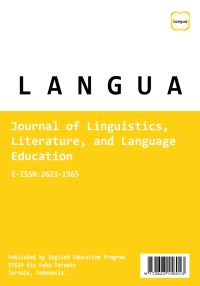The Grammar Translation Method, The Direct Method, and The Audio-Lingual Method
Abstract
This article briefly presents the characteristics of different teaching methods, namely the grammar translation method, the direct method, and the audio-lingual method. Many authors have discussed each method separately and in this brief communication I will present the characteristics of each comparable method. The significance of the discussion in this article, theoretically and practically, can help teachers decide which method will work best for them and their students. By having knowledge about the characteristics of each method, teachers can make optimal use of the method they choose so that learning outcomes can be achieved optimally.
Downloads
References
Alemi, M., and Tavakoli, E. (2016). Audio Lingual Method. Third International on Applied Research in Language Studies, 2016, pp.1-5
Anderson, M., Freeman, L.D. (2011). Techniques & Principles in Language Teaching (Third Edition).
Anosh, M., Batool, A, Batool, N., Iqbal, N. (2017). The Direct Method: A Good Start to Teach Oral Language. International Journal of English Language Teaching, 5(1), 37-40. http://www.eajournals.org/wp-content/uploads/The-Direct-Method-A-Good-Start-to-Teach-Oral-Language.pdf
Jacobs, H. H. (1989). Interdisciplinary Learning in Your Classroom. Introduction to our expert. https://www.thirteen.org/edonline/concept2class/interdisciplinary/index.html
Mart, T. C. (2013). The Audio-Lingual Method: An Easy way of Achieving Speech. International Journal of Academic Research in Business and Social Sciences, 3(12), 63-65. https://citeseerx.ist.psu.edu/viewdoc/download?doi=10.1.1.686.2&rep=rep1&type=pdf
National Standards in Foreign Language Education. American Council on the Teaching of Foreign Language, Inc. 700 S. Washington St., Suite 210. Standards for Foreign Language Learning.
The Provider of Asian Artistic Traditions (2004-2015). Blog: Dado (Korean Tea Ceremony) – The Way of Tea. http://www.antiquealive.com/Blogs/Dado_Korean_Tea_Ceremony.html
Zillo, F. (1973) The Birth and Death of the Audio-Lingual Method: US Department of Health, Education and Welfare National Institute and Education. https://files.eric.ed.gov/fulltext/ED080005.pdf
Copyright (c) 2021 Risnawati Djauhar

This work is licensed under a Creative Commons Attribution 4.0 International License.
Authors who publish with Langua Journal of Linguistics, Literature, and Language Education agree to the following terms:
- Authors retain copyright and grant the journal right of first publication with the work simultaneously licensed under a Creative Commons Attribution License that allows others to share the work with an acknowledgement of the work's authorship and initial publication in Langua.
- Authors are able to enter into separate, additional contractual arrangements for the non-exclusive distribution of the journal's published version of the work (e.g., post it to an institutional repository or publish it in a book), with an acknowledgement of its initial publication in Langua.
- Authors are permitted and encouraged to post their work online (e.g., in institutional repositories or on their website) prior to and during the submission process, as it can lead to productive exchanges, as well as earlier and greater citation of published work.






